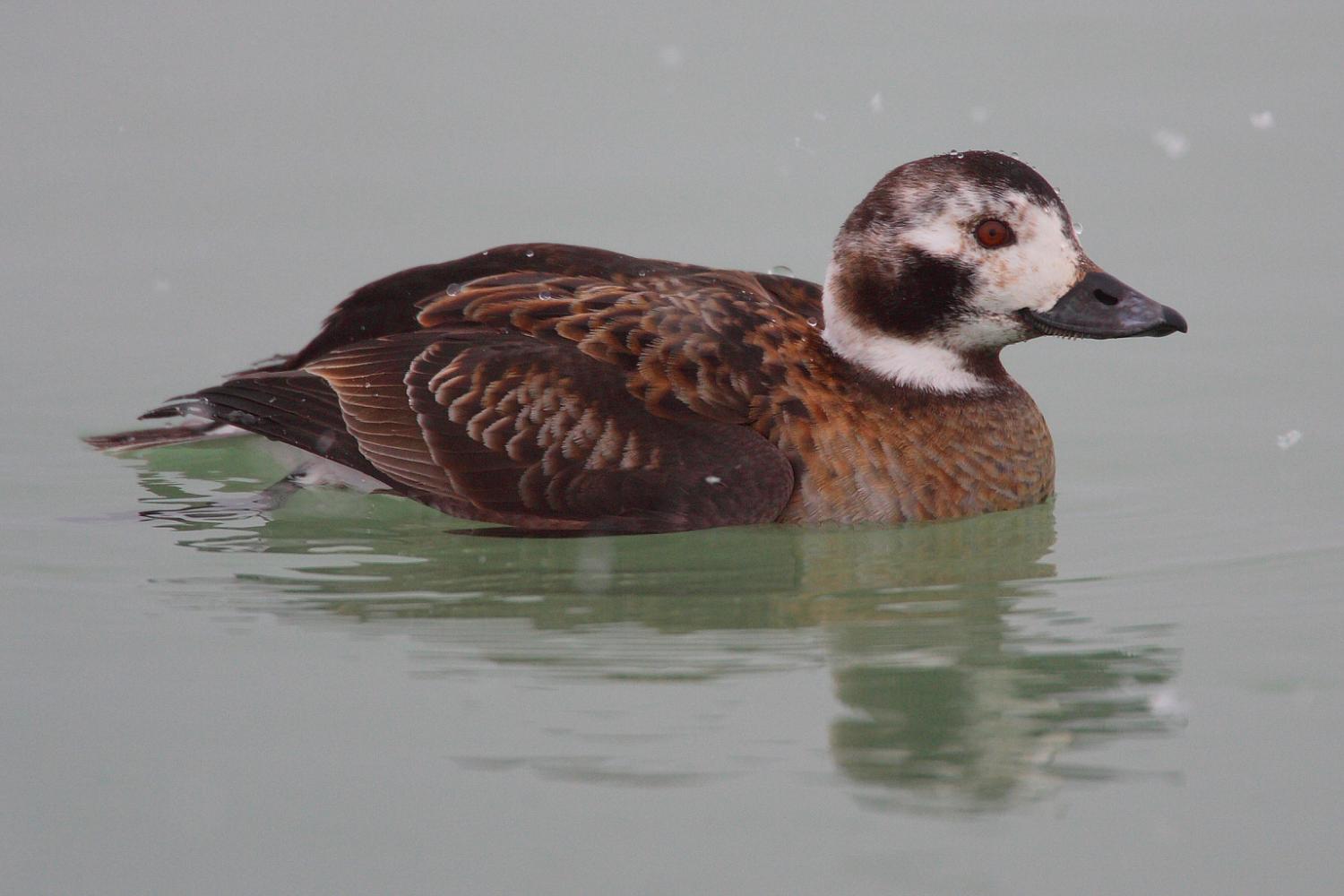Species of Thailand
Long-tailed duck
Clangula hyemalis
Carolus Linnaeus, 1758
In Thai: เป็ดหางยาว
The long-tailed duck (Clangula hyemalis), commonly known in North America as oldsquaw, is a medium-sized sea duck. It is the only living member of its genus, Clangula. This was formerly used for the goldeneyes, with the long-tailed duck being placed in Harelda, but the latter is the type species of the genus. An undescribed congener is known from the Middle Miocene Sajóvölgyi Formation (Late Badenian, 13–12 Mya) of Mátraszőlős, Hungary.
Description
Adults have white underparts, though the rest of the plumage goes through a complex moulting process. The male has a long pointed tail (10 to 15 cm in abbr=on long) and a dark grey bill crossed by a pink band. In winter, the male has a dark cheek patch on a mainly white head and neck, a dark breast and mostly white body. In summer, the male is dark on the head, neck and back with a white cheek patch. The female has a brown back and a relatively short pointed tail. In winter, the female's head and neck are white with a dark crown. In summer, the head is dark. Juveniles resemble adult females in autumn plumage, though with a lighter, less distinct cheek patch.
| Standard Measurements | |
|---|---|
| length | 17.5 - 23.5 in mm abbr=on order=flip |
| weight | 740 g lb abbr=on |
| wingspan | 28 in mm abbr=on order=flip |
| wing | 209 - 228 mm in abbr=on |
| tail | 165 - 237 mm in abbr=on |
| culmen | 26 - 30 mm in abbr=on |
| tarsus | 34 - 38 mm in abbr=on |
The males are vocal and have a musical yodelling call ow, ow, owal-ow.
Ecology
Their breeding habitat is in tundra pools and marshes, but also along sea coasts and in large mountain lakes in the North Atlantic region, Alaska, northern Canada, northern Europe, and Russia. The nest is located on the ground near water; it is built using vegetation and lined with down. They are migratory and winter along the eastern and western coasts of North America, on the Great Lakes, coastal northern Europe and Asia, with stragglers to the Black Sea. The most important wintering area is the Baltic Sea, where a total of about 4.5 million gather.
The long-tailed duck is gregarious, forming large flocks in winter and during migration. They feed by diving for mollusks, crustaceans and some small fish. Although they usually feed close to the surface, they are capable of diving to depths of 60 m ft abbr=on. According to the Audubon Society Field Guide to North American Birds they can dive to 80 fathoms (146 meters or 480 feet). They are the only ducks that use their wings to dive, which gives them the ability to dive much deeper than other ducks.
Name
In North American English it is sometimes called oldsquaw, though this name has fallen out of favour under influence of negative connotations of the word squaw in English usage. Some biologists have also feared that this name would be offensive to some Native American tribes involved in the conservation effort. The American Ornithologists' Union stated that "political correctness" was not sufficient to change the name, but "to conform with English usage in other parts of the world", it officially adopted the name "Long-tailed Duck". The scientific name is derived from Latin clangere, "to resound", and hyemalis, "of winter". In 2020, following months of protests against racism, the Bird Names for Birds campaign was created to urge the American Ornithological Society to address the issue of eponyms and honorific bird names with derogatory or oppressive implications.
Status
The long-tailed duck is one of the species to which the Agreement on the Conservation of African-Eurasian Migratory Waterbirds (AEWA) applies.
This article uses material from Wikipedia released under the Creative Commons Attribution-Share-Alike Licence 3.0. Eventual photos shown in this page may or may not be from Wikipedia, please see the license details for photos in photo by-lines.
Category / Seasonal Status
Wiki listed status (concerning Thai population): Accidental
BCST Category: Recorded in an apparently wild state within the last 50 years
BCST Seasonal status: vagrant (non-breeding visitor with three or fewer records)
Scientific classification
- Kingdom
- Animalia
- Phylum
- Chordata
- Class
- Aves
- Order
- Anseriformes
- Family
- Anatidae
- Genus
- Clangula
- Species
- Clangula hyemalis
Common names
- Thai: เป็ดหางยาว
Synonyms
- Harelda hyemalis, Carolus Linnaeus (1758)
- Anas hyemalis, Carolus Linnaeus (1758)
Photos
Please help us review the bird photos if wrong ones are used. We can be reached via our contact us page.
Range Map

- Chiang Saen District, Chiang Rai
- Nong Bong Khai Non-Hunting Area

